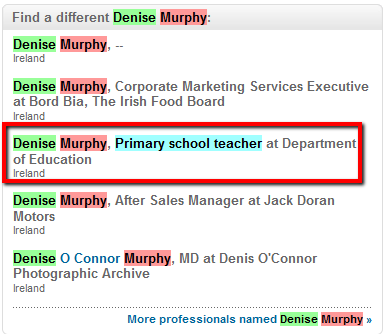Would you like to know how I search LinkedIn when sourcing for talent?
I don’t have a premium LinkedIn account, so you may be surprised to learn that I don’t X-Ray search LinkedIn all that often.
I’ll tell you why in a moment, but first I would like to share my inspiration for this post.
I recently read a great post that addressed an issue with X-Ray searching LinkedIn and that pointed out that pattern recognition is critical to effective online sourcing.
I could not agree more – truly dynamic pattern recognition is something I think is unique to humans and is something that I believe cannot be replicated by applications claiming to leverage artificial intelligence, semantic search, and Natural Language Processing (NLP). I could elaborate further on this topic, but that would unfortunately bore 98% of my readers, so I will save it for another post that they can choose not to read later. :-)
Suffice it to say I wholeheartedly agree that is it more important to have the right investigative thought process than to have any specific Boolean search string or pre-built X-Ray search.
Getting back to how I specifically search LinkedIn to find people – you first need to understand some of the significant issues associated with using Internet search engines in an attempt to find public LinkedIn profiles. In other words, you should know they “why” before the “how.”
As an added bonus, you’ll also find that I’ve discovered that Bing and LinkedIn apparently don’t play well together anymore, and I’ll issue a LinkedIn Sourcing Challenge to the international sourcing and recruiting community to crowdsource the solution.
The Problem with Using Google to X-Ray Search LinkedIn
In the aforementioned article, the author suggested to search for the phrase “contact settings” in Google X-Ray searches of LinkedIn to isolate public profiles from non-profile false positive search results rather than using slightly more labor/Boolean intensive search logic such as the example they use site:ie.linkedin.com (inurl:in | inurl:pub) -inurl:dir -inurl:title “primary school teacher” or even one of my takes on the same search: site:ie.linkedin.com in | pub -dir “primary school teacher” (short and sweet!).
I’ve searched for other terms on LinkedIn that are well-indexed, but I had never tried the “contact settings” phrase before, so I immediately tested it and it seems to work quite well to isolate profiles from non-profile results.
I really appreciate the fact that they did not simply take someone else’s X-Ray string and use it without wondering if there might be another way. As Thomas Edison once said, “There is always a better way.”
The example Google X-Ray search they used in their post pulls 270 results from LinkedIn: site:ie.linkedin.com “contact settings” “primary school teacher”
You’ll notice that if you click the links for the search results above, I take you to the last page of results. That’s because no one should care about Google’s estimated number of results that show up on page 1 – you should always click through to the last page. At that point, you can click Google’s “repeat the search with the omitted results included” – although you still won’t get the number of results that Google estimated page 1 if you click through to the last page, and you gain mostly (if not all) duplicates.
As I clicked through the search results for primary school teachers in Ireland, I noticed a pattern that the article’s author prepared me for – false positive results coming from this area on profiles – let’s call it the “box of false positives” :-)
They probably didn’t, but if anyone at LinkedIn actually thought to design any part of that section to make it more difficult to precisely X-Ray search LinkedIn, my hat’s off to you – it’s good work.
Intentional or not, that part of public profiles is responsible for producing a solid quantity of false positive results – profiles that actually don’t match your search.
How many?
I’m glad you asked, because I actually took the time to find out – at least with the search suggested by the www.socialtalent.co blog author.
Out of the first set of results from the site:ie.linkedin.com “Contact Settings” “Primary School Teacher” search, without clicking to search with the omitted results included, I got 270 results.
I scraped all 270 results into Excel and sorted them by name. Of those 270, there are 193 unique names, leaving 77 duplicate names – which is nearly 30%.
There are a few duplicate profiles of people who obviously created one LinkedIn profile, abandoned it and/or simply created another one – here is one example.
However, the vast majority of the duplicates come in the form of false positive results of people who share the same name of a legitimately matching positive result, but when you click through to their profile, there are clearly a false positive, as the phrase “primary school teacher” cannot be found anywhere on the profile. In many cases, not even in the box of false positives.
Here is an example of 5 hits for the same name – if you take the time to open all 5 results, only one of results mentions “primary school teacher.”
Taking a look at one of the false positive results, you will see there is actually no mention of the search phrase we used of “primary school teacher” – not even in the box of false positives. However, clicking on the cached result shows us why the result came up – and it is directly attributable to the false positive box:
So, while the actual profile page on LinkedIn doesn’t currently have any mention of “primary school teacher,” it did actually have a mention of “primary school teacher” from the “More professionals named _______” box the last time Google took a snapshot of that person’s public profile. By the way – has anyone else noticed that Google’s cached results are acting buggy lately?
Now that you have seen perhaps one of the largest flies in the ointment of LinkedIn X-Ray search (nearly 30% false positives), let me tell you how I personally go about searching LinkedIn.
How I Search LinkedIn
I start searching LinkedIn using LinkedIn’s search interface 100% of the time.
Why?
Because:
- With its structured fields and facets, LinkedIn’s search interface is much more powerful and precise than any Internet search engine
- I’ve taken the time to significantly build my LinkedIn network so that a great number of people show up in my search results within my network – all sourcers and recruiters should do the same
- Using an Internet search engine to search for public LinkedIn profiles is intrinsically limited and challenging – false positives will always be an issue, and LinkedIn and the Internet search engines can change their indexing at any time – what works well today may not work well tomorrow
The only time I really X-Ray search LinkedIn (other than tinkering around) is to find the specific public profiles of LinkedIn search results who are beyond my LinkedIn network.
I’ve found that when I grab phrases or combinations of terms from LinkedIn profiles that are beyond my LinkedIn network and search for them on Google or Bing, I typically get very “clean” results – in other words, the profile i am looking for, without a load of false positives.
Ultimately, I have found that the return on time invested when searching LinkedIn is higher when you start with LinkedIn and use Internet search engines to find the profiles of specific people, as opposed to starting a search with an Internet search engine to X-Ray LinkedIn to identify people.
LinkedIn No Longer Plays Nice with Bing?
As a timely example of point #3 above, I was going to use Bing to demonstrate a few things in this post – specifically to show how use can use Bing to create a very concise and simple X-Ray search that only uses the word “powered” to target public profiles. However, I have found that something has changed significantly with how well Bing and LinkedIn play together.
For example, check out how only 28 results come back from this Bing search: site:ie.linkedin.com. Interestingly, Yahoo’s Site Explorer pulls over 550,000 results. Google pulls over an estimated 800,000 results with the same simple search.
Also interesting is that a simple search like this site:linkedin.com java “greater atlanta area” on Bing only pulls 44 results, when it should pull tens of thousands of results with a load of false positives, as it does on Google.
Score 1 for Team LinkedIn if they had anything to do with recently altering Bing’s heretofore superior LinkedIn X-Ray search results.
If anyone has any insight into the very recent changes in Bing X-Ray searches of LinkedIn, please let me know.
LinkedIn X-Ray Search Challenge
Let’s crowdsource a LinkedIn sourcing solution!
Similar to my recent LinkedIn Sourcing Challenge to eliminate location-based false positive results, I’d like to challenge the international sourcing and recruiting community to come up with LinkedIn X-Ray searches that only return profiles that match the keywords searched for, and do not return any false positive results coming from the “Find a different ________” box of false positives.
Is it possible?
Let’s find out!


